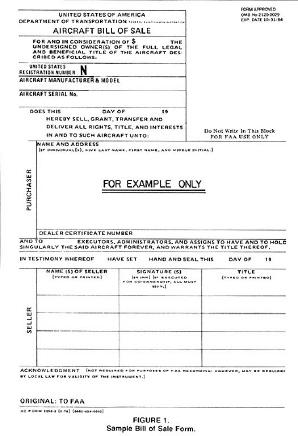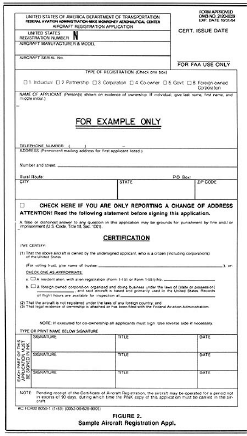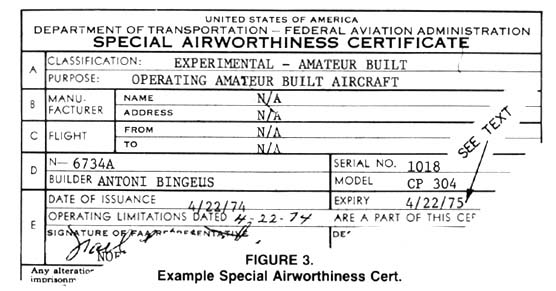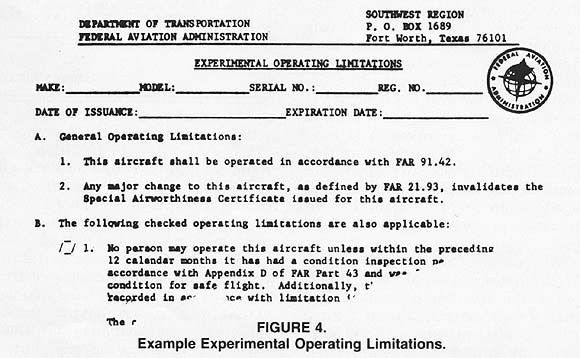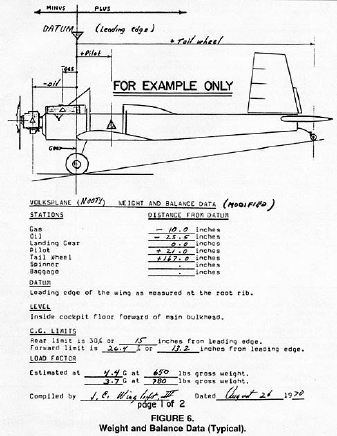When You Buy or Sell a Homebuilt
By Tony Bingelis (originally published in EAA Sport Aviation, November 1984)
HOW DO YOU transfer the ownership of homebuilt aircraft? A partially completed project? Does the FAA need to be notified? If so, how? What else should be done and who does it?
The mechanics of, or rather the procedure for, selling or buying a homebuilt is relatively simple but it does involve specific forms, actions and understandings important to both the seller and buyer alike.
Needless to say, it is the buyer who assumes the greatest responsibility in assuring that the transaction is properly completed and documented.
First the Obvious
It is so obvious that you would think it unnecessary to ask . . . but I will. Does the seller of the aircraft (or a partially completed homebuilt project) have the right to sell it? In other words, is that individual the legal owner? The sole owner? If the right to sell is encumbered by a co-owner or others, they must also be included in the transaction. Sometimes a flyable homebuilt, or a partially completed project, is put up for sale to settle an estate. Be sure that whoever is handling it has the legal right to effect the transfer in ownership.
Unlike autos, there is no title per se issued for an aircraft. The closest equivalent is a Bill of Sale and Aircraft Registration.
Most homebuilders handle the sale of a project, engine, propellers, radios and the like pretty casually. Sometimes there is not even a receipt or Bill of Sale exchanged. And more often than not, even when a receipt is scribbled out, neither party would ever think of listing the serial number(s) or describing the property.
And then, there is stolen property. Of course, a buyer must beware! But he should not become so paranoid about the transaction that he feels compelled to demand unnecessary or unreasonable documentation, notarized receipts, statements and the like, to the degree that the seller is overwhelmed. He could, in frustration, throw up his hands and walk away.
There is no reason why the sale of a partially completed project cannot be accomplished with a dated and signed Aircraft Log Book entry. If no Aircraft Log Book had been started, a written receipt briefly describing the acquisition, dated and signed in ink, should suffice.
The FAA And "Approved" Kits
There is more you should know about purchasing a partially completed aircraft project. You should be aware of certain requirements that the FAA has for "Kit-built" aircraft. For one thing, in order to help establish ownership of a homebuilt, the FAA will ask that you produce the receipts for all kits that were purchased during the building of that aircraft. Secondly, you should determine, beforehand, when you buy somebody's project, that the FAA will allow it to be certificated as an Amateur-Built aircraft. Some kits are so complete that the FAA may not accept a builder's word that he had constructed 51% or more of the airplane. The burden of proof is on the builder. For this reason it, is important to maintain a good record of the construction. Work photos, diary entries and inspections by an EAA Technical Counselor can do much to validate a claim for the construction work accomplished.
To be on the safe side of FAA's 51% requirement, you should assure yourself that the kit-built airplane or project you buy is on the "FAA approved list". Now understand this . . . the FAA does not approve any kit design in the sense that it is a good safe airplane or that it is strong as a fighter plane and capable of soaring like an eagle. Not at all. FAA approval for a homebuilt kit design is merely an acknowledgement that, in their estimation, anyone who buys and constructs an aircraft from that kit will actually have to build 51% or more of the airplane. And that it would, therefore, be eligible for certification in the Amateur-Built Category.
Why such a fuss over this detail? Well, what if you did buy an airplane project that was almost complete. One that was being constructed from a very complete kit where all the parts were pre-formed or already made when purchased . . . and the FAA refused to certificate it? What then?
Without FAA certification you could not legally fly that airplane. Oh sure, you might be permitted to license it in one of the other Experimental Categories such as Research and Development, Exhibition, Market Survey, Crew Training or Racing. But these categories are very restrictive. You would never have free use of the aircraft without having to make repeated reapplications for most every flying event or experiment. Think about it.
Aircraft Bill of Sale
An Aircraft Bill of Sale is a very important piece of paper, particularly if you are the buyer, as you will not be able to register your newly purchased homebuilt unless you can submit proof of ownership that meets the requirements of FAR Part 47.
If the aircraft was not purchased from the last registered owner, you will have to prove that you are the current legal owner. To do this you must produce conveyances completing the chain of ownership from the last registered owner, through all the intervening owners, to yourself, the present applicant.
The FAA has a standard Aircraft Bill of Sale Form (AC Form 8050-2) for anyone who wants to use it. Its use is not mandatory. Still, it is much more convenient and easier to use this Bill of Sale form than to make your own. For one thing, it contains all the elements of information that the FAA wants and it does meet the requirements of FAR Part 47. For another, the form is free and readily available from either the FAA or most any airport where aircraft are bought and sold. This AC Form 8050-2 may be used to record the sale of any certificated aircraft, including aircraft in the Amateur-Built category.
One more note. As the buyer, you are the one who must assume the responsibility for sending the original copy (signed in ink) to the FAA Aircraft Registry!
Aircraft Registration
When you purchase, a homebuilt aircraft it becomes your responsibility to get it registered as soon as practicable.
Naturally, there is a form (AC Form 8050-1) you must use to effect the change in aircraft registration. It is prepared in triplicate. The WHITE original and the GREEN copy of the form is mailed to the Aircraft Registry along with a $5 recording fee and proof of ownership (Aircraft Bill of Sale). For your convenience, the address is: FAA Aircraft Registry, Mike Monroney Aeronautical Center, P. O. Box 25504, Oklahoma City, OK 73125.
Carry the PINK copy of the Aircraft Registration Application in the aircraft as it grants you temporary authority to operate the aircraft pending receipt of the verified original registration.
Special Airworthiness Certificate
In addition to sending off the Bill of Sale and Aircraft Registration Application you have a few more details to attend to.
The aircraft must have a current airworthiness certificate on board. This is a pink colored form, FAA Form 8130-7, SPECIAL AIRWORTHINESS CERTIFICATE, that is issued with the original certification of the aircraft. It should be displayed someplace in the aircraft. Check that the N-Number is correct and check to see whether there is an EXPIRATION DATE or the entry, "INDEFINITE".
The presence of an Expiry date entry would indicate that the original builder of the homebuilt has not yet flown off the mandatory flight hours in an assigned test area.
An "INDEFINITE" entry, on the other hand, indicates that the original flight test area restrictions have been removed. If this is the case, this aircraft may be flown, at will, to just about anywhere, anytime . . . as long as the flights are conducted in accordance with the aircraft's operating limitations document.
Experimental Operating Limitations
The Experimental Operating Limitations certificate is a companion document to the Special Airworthiness Certificate.
You should understand that a homebuilt must be operated in accordance with the operating limitations issued for it by the local FAA District Office. Each of the FAA Regions in the country probably has a different format for the document used for this purpose. That is because each FAA Region issues its own Experimental Operating Limitations document based upon their own interpretation of the criteria for its issuance. This criteria is outlined in their handbook, "FAA Airworthiness Certification of Aircraft and Related Approval."
If the aircraft's Experimental Operating Limitations had an "INDEFINITE" expiration date (same with the Special Airworthiness Certificate) no further action with the FAA is required.
If, however, both the Experimental Operating Limitations and the Special Airworthiness Certificate contain expiration dates, on the date of your purchase that aircraft must be considered to be "grounded". (On the sale of a homebuilt, the operating limitations document and the Special Airworthiness Certificate, as issued for an aircraft still undergoing its mandatory 25 to 40 hours in a restricted flight test area, is automatically cancelled (at least in this FAA Region). This means that you (the new owner) would then have to go to the nearest FAA MIDO (District Office) and obtain a new Experimental Operating Limitations document and a new Special Airworthiness Certificate. This process may entail another inspection of the aircraft by the FAA. At any rate, you better check with your local FAA inspector regarding the status of these two important documents.
Even if the aircraft you purchase does have an "INDEFINITE" expiration date on both certificates, the airplane may continue to be flown in accordance with the operating limitations issued it, ONLY if it has had, in the preceding 12 months (as indicated by an appropriate entry in the Aircraft Log Book), a condition inspection (Annual Inspection) performed by:
1.The original builder (provided he has been issued a Repairman, Aircraft Builder Certificate for the particular homebuilt), or
2. A certified mechanic with appropriate ratings, or
3. A repair station with appropriate ratings.
In other words, a homebuilt, like a commercially produced airplane, must also have current "Annual Inspections".
Aircraft Log Book
As you probably know, the Aircraft Log Book is a very important document and you should check it carefully. And, as already mentioned, a current inspection status should be reflected by an appropriate entry.
The Aircraft Log Book is also a historical record of the aircraft's origin and use. In it should be recorded all malfunctions, repairs, modifications, inspections and hours flown. (Amateur-Built aircraft are not required to have an Engine Log Book or Propeller Log Book, so don't bother looking for either.) Because of the importance of the Aircraft Log Book during the construction and certification process, every builder of a homebuilt should conscientiously make accurate and detailed entries.
As for selling the aircraft, a Log Book entry by the seller, dated and signed, would be appropriate for record purposes.
Weight and Balance Data
The weight and balance data is another required document and should be available with the aircraft. Check with the seller to verify that the figures are still valid. Builders are prone to add and remove equipment without making any further entries to the original weighing figures and computations. This weight and balance report or data can be in any form. Figure 6 illustrates a portion of a typical weight and balance record.
You don't have to do anything with this data . . . just know where it is and become familiar with the center of gravity location and loading limits.
Summary Check List
The documents and necessary actions involved in the sale or purchase of a homebuilt can be tabulated as follows:
1. Aircraft Bill of Sale (AC Form 8050-2): Copy to FAA signed in ink.
2. Aircraft Registration Application (AC Form 8050-1): Keep pink copy with airplane as temporary authority.
3. Special Airworthiness Certificate: Check N-Number an expiration date. If "INDEFINITE", no further action required, otherwise see text.
4. Experimental Operating Limitations: Check N-Number and expiration date. If "INDEFINITE", no further action required, otherwise see text.
5. Aircraft Log Book: Check for current "Annual Inspection". Stays with aircraft.
6. Weight and Balance Data: Check for presence in aircraft and currency.
NOTE: If you wish to get a new N-Number or transfer one from an airplane you now have, things can get complicated. All items referenced above will require the change and additional coordination with FAA. The data plate affixed to aircraft would also be affected. Keep the aircraft's original number and the transfer of ownership will be much easier. The two "big things" are the Bill of Sale and the Registration Application. The other papers or documents may not require further action except as pointed out in the text.
If you are the seller . . . spend your money wisely (another project, perhaps?).
If you are the buyer, take good care of your investment and enjoy it.
